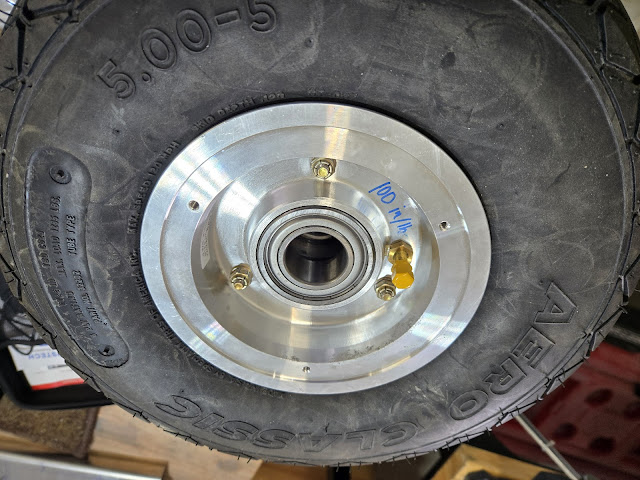Today was spent working on the connectors for the ACM. Some of the connections won't be made until I buy the avionics (which come with wiring harnesses pre-built), but most of the wiring from the rest of the plane can be terminated at this point. The Flyleds lights I bought came with a PCB that is an add-on to the ACM's Aircraft Rear connection, so that went on first. Most of the pins just pass through unchanged, but for the lighting wiring, they do some fancy stuff with the board to allow for different light functions that wouldn't be possible otherwise.

It looks like an absolute disaster, but there is a method to the madness. Pretty much every D-Sub connector has wiring that is coming from both the right and left side, so the wire bundles have to split and go in different directions on the subpanel. Right now the extra length of wire is just hanging down, but once I'm done it will be zip tied in bundles and route through a number of adel clamps. For most of the wiring I left enough slack to leave a loop behind the subpanel, just in case I ever need to redo a connection and need a few extra inches. I do have a couple of wires that don't have enough slack for a service loop, but that's not the end of the world - at least not a big enough deal to redo anything.
I had originally planned on labeling every single wire, but as I got rolling on making the connections, I realized that was kind of overkill. Adding the clear shrink tubing over labels also really starts to make the bundles bulky and hard to manage. For wiring that comes in as singles, I did label them. But for wiring that comes in as a multi-conductor group, I just labeled the group (for example, instead of labeling all of the separate data wires in the elevator trim, I just labeled the whole shielded bundle "Elevator Trim"). I have a spreadsheet with all of my connections, including wire colors, so for future reference, as long as I can find the right bundle for "Roll Servo," I can then easily just reference the spreadsheet to know which wire I'm looking for.
AFS included a wiring harness for the ADSB and transponder (also includes the GPS connection) since those are panel devices and not coming from other parts of the plane. The ADSB, GPS, and transponder all go into a single D-Sub on the ACM. Unfortunately, they made the transponder bundle too short for my setup. I chopped the old wire out and made a new harness about 8" longer. Their harnesses are nice and professional looking with snakeskin wrap, so I gave that a shot just for kicks. I was originally going to put snakeskin on all of my bundles just to make everything really clean looking, but with all of the offshoots it's not super practical. Once I'm all done maybe I'll do some wire wrap on the big bundles.
I measured and made the coax terminations for the ADSB and transponder too. I left extra length in the ADSB for a service loop, but I ran the transponder coax without much extra. I'm already right at the edge for length on that antenna wire (signal starts to degrade if the coax gets too long for the transponder). It's yet to be seen if all of my terminations are good!
I only have a few connections left. The Dynon GPS connects to the pigtail harness that goes into the AFS made ADSB/Xpndr/GPS D-Sub. I think they have that pigtail on the harness just so people don't have to add the GPS wires to the larger D-Sub at the ACM end. I contemplated just pulling that pigtail out when I was fixing the transponder harness (then I'd just wire the GPS directly to that D-Sub vs using the pigtail), but decided not to bother. Outside of that, I think the only other connection I have to make is for the ADAHRS. I have that cut and pins crimped on, but I don't have the right D-Sub for it. For some reason AFS made those D-Subs on the ACM male, whereas almost all of the rest are female. That would be fine, except they only sent male 9 pin D-Subs, so I don't have a female mate to use for that ADAHRS. I'm definitely getting my free shipping money's worth from Amazon these days.
Once I'm done with those connections, I think I'll be finished with wiring for now. I would love to finalize these bundles and tidy them up, but I can't until I've gotten further on the firewall. The vertical wire run up the firewall goes right over the top of a line of rivets on each side that won't be completed until I hang the engine, run control cables, and close out the big cutout in the firewall. If I adel clamp the vertical wire runs in place now, I'll have to move them out of the way once I'm ready to rivet those stiffeners.
There are some wires that don't have a home in the ACM, like the heated seats power. I'm not going to be using traditional circuit breakers for anything, but instead am just using a simple fuse block. There's no reason I'd need to be able to reset heated seats in flight, so a fuse is fine for me. In fact, many of the newer RV designs (like the RV12) use fuses almost exclusively. Safe, light and low maintenance. I haven't figured out yet where the fuse block is going to live though. I may have to wait until I have the comm unit mounted to the subpanel and the center stack in place to know how much subpanel real estate I have left.























